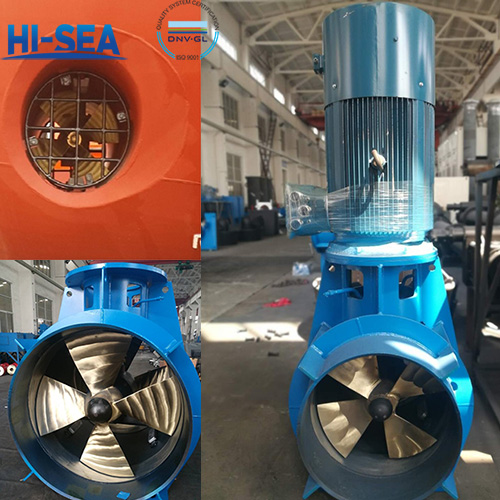
Mian functions of marine tunnel thruster
(1) Ships can be safely and quickly docked from the dock;
(2) When ships equipped with side thrusters approach and leave the dock, the number of tugs can be saved or no tugs can be used, so the cost can be reduced;
(3) For all-container ships, ro-ro ships or huge tonnage oil tankers with a large wind-affected area, when passing through narrow channels or entering and leaving Hong Kong, the ship is required to sail at low speed. However, at this time, the rudder efficiency is very poor and it is difficult to meet the manoeuvring requirements. After installing a side thruster, the ship's manoeuvrability can be significantly improved. However, the effect of various side thrusters on improving ship manoeuvrability has a lot to do with the ship's speed. Generally, at low speeds (generally no more than 5kn), the thrust effect generated by the thruster is better. As the ship's speed increases, the lateral thrust will be lost due to the low-pressure area created behind the nozzle. This negative effect is not obvious initially, but when the ship speed is very high, the effect is very significant.
Overview
The main functions of a marine tunnel thruster are to enhance a vessel's maneuverability and provide greater control, especially at low speeds and in confined spaces. Here are the key functions:
1. Sideways Movement:
Docking and Undocking: Tunnel thrusters enable a vessel to move sideways, which is particularly useful when docking or undocking in tight spaces.
Berthing: Helps in precise positioning alongside a pier or dock.
2. Enhanced Maneuverability:
Turning: Assists in making tight turns and navigating narrow channels or harbors.
Station Keeping: Helps maintain a fixed position without drifting, which is crucial for operations like loading, unloading, or offshore activities.
3. Improved Control in Adverse Conditions:
Wind and Current Compensation: Provides additional control to counteract the effects of wind and current, keeping the vessel on its intended course or position.
Stability in Rough Seas: Assists in maintaining stability and course in rough seas or strong currents.
4. Precision Maneuvering:
Fine Adjustments: Allows for fine adjustments to the vessel's position, essential for tasks that require high precision, such as docking in crowded marinas or aligning with loading arms in oil terminals.
5. Safety Enhancement:
Collision Avoidance: By providing greater control over the vessel's movements, tunnel thrusters help avoid collisions with other ships, docks, or underwater obstacles.
Emergency Maneuvering: Offers additional maneuvering capability in emergency situations where rapid changes in direction or position are needed.
6. Operational Efficiency:
Reduced Tug Dependence: Reduces the need for tug assistance, lowering operational costs and increasing independence.
Time Savings: Speeds up docking and undocking procedures, saving time in port operations.
For more marine bow/tunnel thruster information, please click here.





